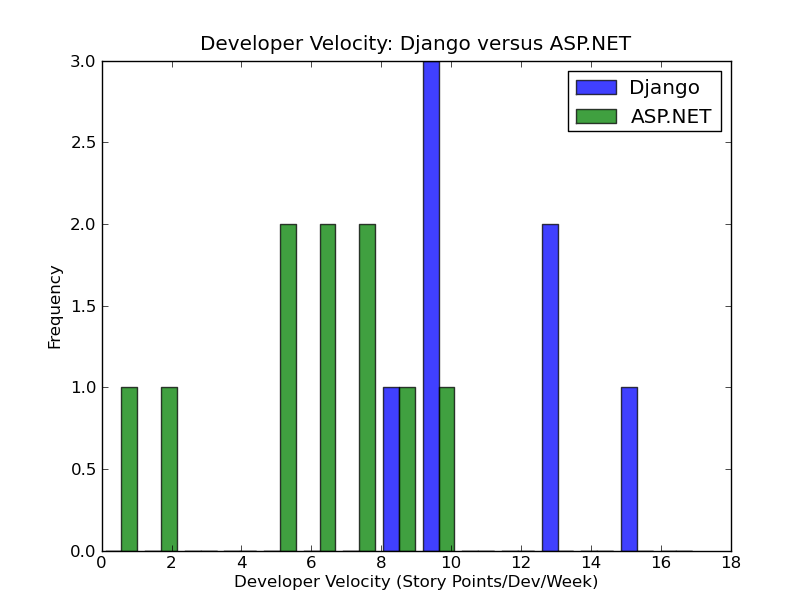
This blog is no longer active, but this post has been retained for reference due to its continued traffic
Python + Django vs. C# + ASP.NET: Productivity Showdown
Python + Django vs. C# + ASP.NET: Productivity Showdown
People are often asking me how and why my department shifted from an ASP.NET environment to Django. I’ve finally gotten around to writing about the process leading up to our decision. I hope people out there find it useful in their own development groups and discussions.
Almost two years ago I was in a rather unlikely situation in that I was running a software engineering department containing both a C# team and a Python team. The Python group was focused on building scientific computing and NLP-type applications, whereas the C# team was focused on building web applications.
A few of us Python folks in the department had already started playing around with Django–building internal web applications and projects outside of work. It did not take long for us to realize the power of Django and how quickly we were able to produce high-quality applications with little effort. This was my (strong) impression, but in order to propose a corporate platform shift I was going to need some data to support my claims.
It slowly dawned on me that I had a perfect test bed. Here we had two teams using different technology stacks within the same department. The same department. That means they shared the same development processes, project management tools, quality control measures, defect management processes. Everything was the same between these groups except for the technologies. Perfect! So like any good manager I turned my teams into unwitting guinea pigs.
The Hypothesis
We can accomplish more with Python + Django than with C# + ASP.NET given the same amount of time without sacrificing quality
Measuring Productivity
For the sake of this study, I defined productivity as a normalized team velocity: how many story points were completed / developer / week. I record the normalized team velocity for each team’s sprint for later analysis.
For those of you unfamiliar with the concept story points I highly recommend Mike Cohn’s Agile Estimation and Planning.
WAIT! You can’t compare story points between teams!
I hear this a lot. Yes, you can. The problem is that most people do not bother creating a common scale or continually calibrate their estimations (within or between groups). Generally, it’s way more work than most groups need to deal with and it doesn’t deliver much utility to most groups so it isn’t often discussed or practiced.
The methods described below should outline the additional calibration work that was performed to ensure a common estimation scale between the two teams.
Methods
Both teams continued business as usual working on projects in parallel. Each sprint consisted of 3-4 developers. It is worth noting that Team ASP.NET did not make use of MS MVC Framework, but they did use Linq-to-SQL for its ORMy powers.
Special care was taken to maintain linkage between the two team’s effort estimates. During sprint planning, each team would use a common story point calibration reference when making estimates. In order to detect any potential deviations in calibration, during several planning poker sessions I included stories that had already been estimated during previous sprints or by the other team; no significant deviations were found.
At the end of each sprint I would calculate the normalized developer velocity ( # of completed story points / developer / week ). These values were recorded for both teams. It should be noted that only Django-based sprints were used in analysis for Team Python.
I recorded results for approximately 6 months.
Results

Normalized Developer Velocities: C# + ASP.NET and Python + Django
The above histogram shows the distribution of normalized velocities associated with each completed sprint. The table below summarizes the distribution of velocities associated each team.
Summary statistics of each team’s normalized developer velocities
| Units: story points / developer / week | C#/ASP.NET | Python/Django |
|---|---|---|
| mean | 5.8 | 11.6 |
| stdev | 2.9 | 2.7 |
| min | .3 | 8.5 |
| max | 9.3 | 15.8 |
The distribution of velocities between the two samples are similarly shaped, but have clear differences in their mean. The average velocity of a C#/ASP.NET developer was found to be 5.8 story points/week. A Python/Django developer has an average velocity of 11.6 story points/week. Independent t-tests reveal these differences as being statistically significant (t(15) = 4.19, p<7.8e-4).
Discussions and Conclusion
Given our development processes we found the average productivity of a single Django developer to be equivalent to the output generated by two C# ASP.NET developers. Given equal-sized teams, Django allowed our developers to be twice as productive as our ASP.NET team.
I suspect these results may actually reflect a lower bound of the productivity differences. It should be noted that about half of the Team Python developers, while fluent in Python, had not used Django before. They quickly learned Django, but it is possible this fluency disparity may have caused an unintended bias in results–handicapping overall Django velocity.
Epilogue
The productivity differences quantified by our findings were then included as part of an overall rationale to shift web-based development platforms. Along with overall velocity differences, the costs associated with maintaining each environment were considered: OS licensing and database licensing for development and production environments, as well as costs associated with development tools. I’m happy to say we are now a Python and Django shop.
Updated:
Several good questions over at Hacker News